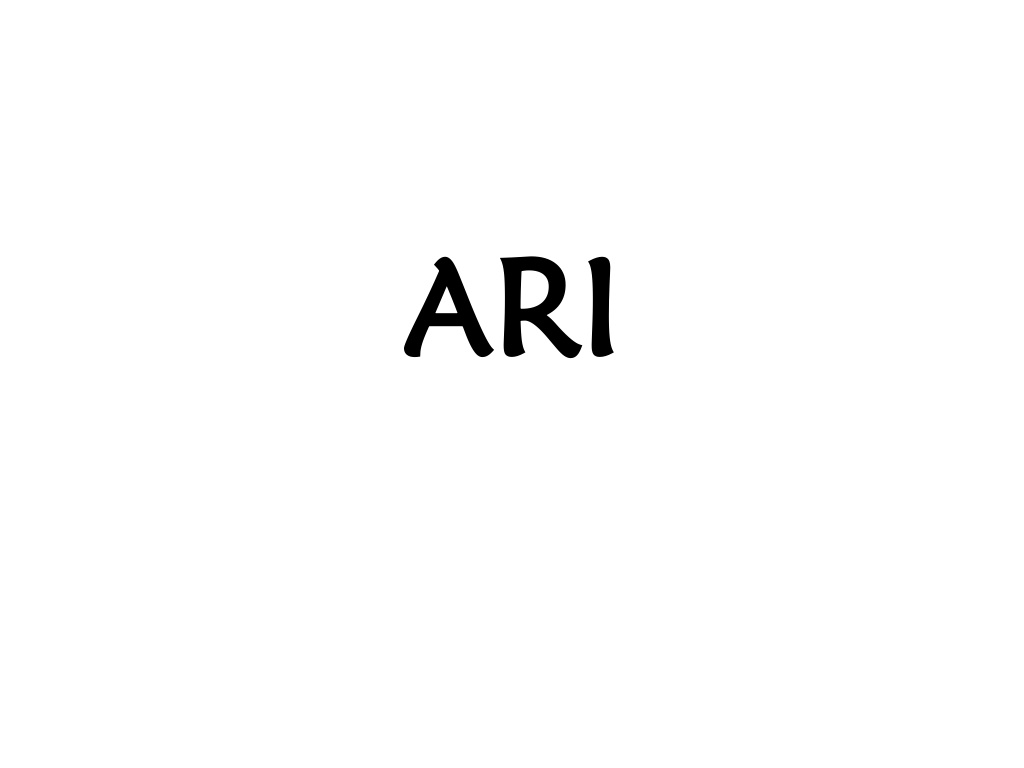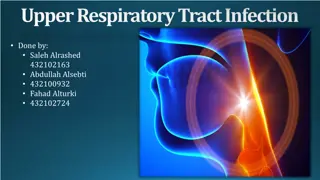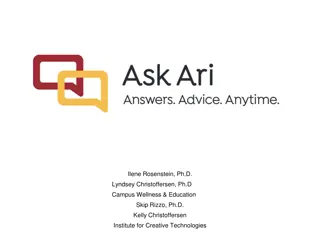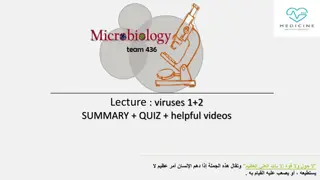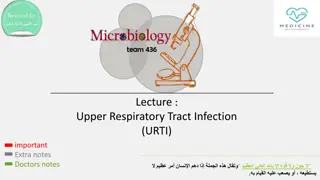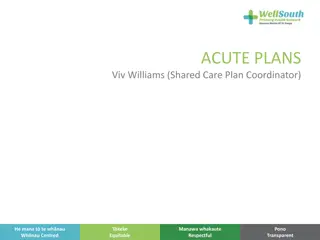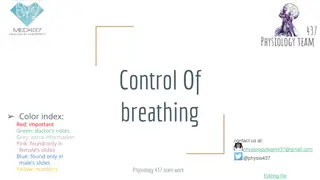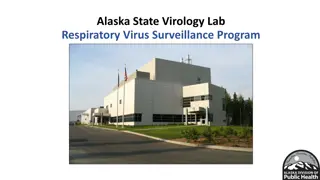Understanding Acute Respiratory Infections (ARI): Symptoms, Classification, and Transmission
Acute Respiratory Infections (ARI), characterized by sudden onset respiratory symptoms affecting the respiratory system from nose to alveoli, are a complex group of diseases caused by various agents. Symptoms include pain in the sinuses, nasal congestion, fatigue, sinusitis, coughing, and more. The World Health Organization (WHO) classifies ARIs based on the anatomical location of the infection above or below the epiglottis. Transmission commonly occurs through airborne routes and person-to-person contact. Clinical assessment involves considering the age of the child, duration of illness, and past medical history.
Download Presentation

Please find below an Image/Link to download the presentation.
The content on the website is provided AS IS for your information and personal use only. It may not be sold, licensed, or shared on other websites without obtaining consent from the author. Download presentation by click this link. If you encounter any issues during the download, it is possible that the publisher has removed the file from their server.
E N D
Presentation Transcript
ARI ARI
Definition: Definition: Sudden Sudden onset respiratory respiratory system including including para pleural pleural cavity cavity. . onset of of infection infection of system from para- -nasal nasal sinuses, of any any part nose to sinuses, middle part of to alveoli, alveoli, middle ear of the the from nose ear & & ARI ARI constitute constitute a a complex of of diseases diseases caused caused by agents agents. . U U5 5& & elderly elderly hit 50 50 times times morbidity morbidity & & mortality countries countries complex & & heterogeneous heterogeneous group by a a great great number number of group of etiological etiological hit hardest hardest mortality than than developed developed
WHO Classification: i. AURI : Above epiglottis :sinuses, tonsil, pharynx, middle ear ii. ALRI: Below epiglottis: Epiglottis, larynx, Trachea, Bronchous, Alveloi & pleura
SYMPTOMS Pain areas: in the sinuses Nasal: congestion, loss of smell, post-nasal drip, or sneezing Whole body: fatigue or fever Respiratory: sinusitis or wheezing Speech: hoarseness or laryngitis Throat: irritation of the tonsils or soreness Also common: coughing, headache, inflammation of ear, phlegm, or swollen lymph nodes
Mode of Transmission Mode of Transmission Airborne root Airborne root Person Person- -to to- -person contact maintains transmission person contact maintains transmission CLINICAL ASSESSMENT: CLINICAL ASSESSMENT: Age of child, duration of illness, history of past illness Age of child, duration of illness, history of past illness Able to drink or not (2 months Able to drink or not (2 months 5 year) Feeding well or not (<2 months) Feeding well or not (<2 months) 5 year)
Physical examination Physical examination 1) Count the rate: 1) Count the rate: Full one minute count when child is CALM Full one minute count when child is CALM Persistence of rate is of significance Persistence of rate is of significance Repeat the count in < 2 month age gr. (Breathing is Repeat the count in < 2 month age gr. (Breathing is erratic) erratic) Fast breathing Fast breathing 60/minute in a child < 2 months age 60/minute in a child < 2 months age 50/minute in a child 2 month 50/minute in a child 2 month - -12 months 40/minute in a child 12 months 40/minute in a child 12 months 5 years 2)Look for Chest in drawing: 2)Look for Chest in drawing: When child breaths IN When child breaths IN When effort to breath IN is more than normal When effort to breath IN is more than normal 12 months 5 years
3)Look & Listen for 3)Look & Listen for Stridor Look & Listen for it when child breaths IN Look & Listen for it when child breaths IN Narrowing of larynx, trachea, or epiglottis (croup) Narrowing of larynx, trachea, or epiglottis (croup) 4)Look for Wheeze: 4)Look for Wheeze: When breaths OUT When breaths OUT Narrowing of air passage in lungs Narrowing of air passage in lungs Breathing out phase requires effort Breathing out phase requires effort If similar type in past one year If similar type in past one year Recurrent wheezing 5)Abnormally sleepy or difficult to awake? 5)Abnormally sleepy or difficult to awake? 6)Temperature high or low? 6)Temperature high or low? 7)Severe Malnutrition: 7)Severe Malnutrition: CFR of pneumonia CFR of pneumonia 8)Cyanosis: Sign of hypoxia 8)Cyanosis: Sign of hypoxia Stridor Recurrent wheezing
CLASSIFICATION OF ILLNESS CLASSIFICATION OF ILLNESS: : As per IMNCI guideline child should be As per IMNCI guideline child should be put into one of the four classifications: put into one of the four classifications: 1. 1. Severe pneumonia Severe pneumonia 2. 2. Pneumonia (Not severe) Pneumonia (Not severe) 3. 3. No pneumonia cough or cold No pneumonia cough or cold
Management of Pneumonia in a child age 2 months Management of Pneumonia in a child age 2 months 5 years 5 years SIGNS SIGNS Chest in drawing Chest in drawing (Recurrent wheezing, (Recurrent wheezing, respiratory rate respiratory rate SEVERE PNEUMONIA SEVERE PNEUMONIA No chest in No chest in drawing .Fast drawing .Fast breathing breathing PNEUMONIA PNEUMONIA No chest in No chest in drawing drawing No fast breathing No fast breathing NO NO PNEUMONIA PNEUMONIA If cough > 30 If cough > 30 days refer for days refer for reassessment reassessment Assess & treat ear Assess & treat ear problem or sore problem or sore throat, throat, ifpresent ifpresent. . Advice for home Advice for home care Rx fever if care Rx fever if present. Rx present. Rx wheezing if wheezing if present. present. CLASSIFY AS CLASSIFY AS TREATMENT TREATMENT Refer URGENTLY to Refer URGENTLY to hospital give first dose of hospital give first dose of Antibiotic treat fever if Antibiotic treat fever if present, Wheezing, if present, Wheezing, if present. (if referral not present. (if referral not possible Rx with an possible Rx with an antibiotic & follow antibiotic & follow closely) closely) Advice for home Advice for home care. Give an care. Give an antibiotic Rx fever antibiotic Rx fever if present Rx if present Rx wheezing if wheezing if present. Advice to present. Advice to come after 48 come after 48 hours for hours for reassessment and reassessment and earlier if earlier if condition worsens condition worsens
Reassess after 48 hours Reassess after 48 hours - -a child who is taking an antibiotic for pneumonia. antibiotic for pneumonia. a child who is taking an SIGNS SIGNS WORSE WORSE Not able to drink Not able to drink Has chest Has chest indrawing indrawing Has other danger Has other danger signs signs SAME SAME Improving Improving TREATMENT TREATMENT Refer URGENTLY Refer URGENTLY Change Change Antibiotic or Antibiotic or REFER REFER Complete 5 Complete 5 days of days of Antibiotics Antibiotics
CLASSIFCATION & MANAGEMENT IN YOUNGS INFANTS < 2 months SIGNS SIGNS Stopped feeding well Stopped feeding well convulsions convulsions Abnormally sleepy or difficult to wake Abnormally sleepy or difficult to wake Strider in calm child Strider in calm child wheezing wheezing Fever or low body temperature Fever or low body temperature CLASSIFY AS CLASSIFY AS VERY SEVERE DISEASE VERY SEVERE DISEASE TREATMENT TREATMENT Refer URGENTLY to hospital keep young infant worm. Give 1 Refer URGENTLY to hospital keep young infant worm. Give 1st st dose of an antibiotic dose of an antibiotic SIGNS SIGNS Severe chest in drawing & Severe chest in drawing & fast breathing fast breathing CLASSIFY AS CLASSIFY AS SEVERE PNEUMONIA SEVERE PNEUMONIA No severe chest in drawing & no fast No severe chest in drawing & no fast breathing breathing NO PNEUMONIA COUGH OR NO PNEUMONIA COUGH OR COLD COLD Advice mother to give the following Advice mother to give the following home care: home care: Keep warm Keep warm Breast feed frequently Breast feed frequently Clear nose if it interterm with Clear nose if it interterm with feeding feeding Return URGENTLY IF Return URGENTLY IF Breathing becomes difficult Breathing Breathing becomes difficult Breathing becomes first becomes first Feeding becomes a problem Feeding becomes a problem Young infant becomes sicker Young infant becomes sicker TREATMENT TREATMENT Refer URGENTLY to Refer URGENTLY to hospital keep young infant hospital keep young infant warm. Give first dose of warm. Give first dose of an antibiotic. an antibiotic.
